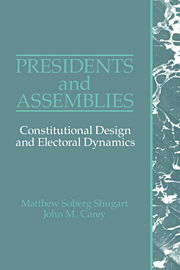Book contents
- Frontmatter
- Contents
- List of tables and figures
- Acknowledgments
- 1 Basic choices in democratic regime types
- 2 Defining regimes with elected presidents
- 3 Criticisms of presidentialism and responses
- 4 The premier-presidential and president-parliamentary experiences
- 5 The constitutional origins of chief executives
- 6 Constitutional limits on separate origin and survival
- 7 Legislative powers of presidents
- 8 Assessing the powers of the presidency
- 9 Electoral dynamics: efficiency and inefficiency
- 10 Electoral rules and the party system
- 11 Electoral cycles and the party system
- 12 Electoral cycles and compatibility between president and assembly
- 13 Conclusions
- Appendix A Electoral rules for one-seat districts and coalition-building incentives
- Appendix B Theoretical explanation for models predicting number of parties in presidential systems
- Bibliography
- Index
9 - Electoral dynamics: efficiency and inefficiency
Published online by Cambridge University Press: 05 June 2012
- Frontmatter
- Contents
- List of tables and figures
- Acknowledgments
- 1 Basic choices in democratic regime types
- 2 Defining regimes with elected presidents
- 3 Criticisms of presidentialism and responses
- 4 The premier-presidential and president-parliamentary experiences
- 5 The constitutional origins of chief executives
- 6 Constitutional limits on separate origin and survival
- 7 Legislative powers of presidents
- 8 Assessing the powers of the presidency
- 9 Electoral dynamics: efficiency and inefficiency
- 10 Electoral rules and the party system
- 11 Electoral cycles and the party system
- 12 Electoral cycles and compatibility between president and assembly
- 13 Conclusions
- Appendix A Electoral rules for one-seat districts and coalition-building incentives
- Appendix B Theoretical explanation for models predicting number of parties in presidential systems
- Bibliography
- Index
Summary
In this and the following three chapters we discuss institutional variations related specifically to elections. The way in which the checks and balances of presidentialism or the relations between president and cabinet in premier-presidentialism play themselves out depends in part on how likely it is that the president confronts an assembly that does not reliably conform to the president's will on legislation. As we shall see, such factors as the method of electing the president and assembly and the relative timing of elections to the two branches are crucial factors in affecting the number of competitors. Thus we must return to the issues with which we started this book and which constitute one of its major themes: the ways in which the processes of electing representatives and of executive formation interact. Here we deal with electoral dynamics, by which we mean the ways in which the practices used for electing the assembly interact with the form and powers of the executive to shape the functioning of democratic regimes. This chapter concerns itself primarily with presidential systems, while the following three deal with both presidential and premier-presidential regimes.
We begin this chapter by reconsidering the tension between representation based on parochial interests versus that which articulates national policy perspectives. We develop an archetype of a presidential system in which the two forms of representation coexist.
- Type
- Chapter
- Information
- Presidents and AssembliesConstitutional Design and Electoral Dynamics, pp. 167 - 205Publisher: Cambridge University PressPrint publication year: 1992



